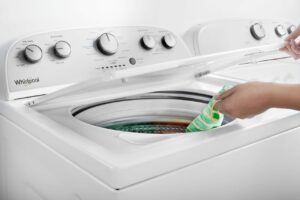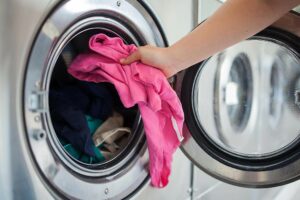A washing machine’s drain function removes water from the tub during the spin cycle The washer pump forces water from the bottom of the appliance into the drain hose. The drain hose loops to the top of the machine and then down to the drain.
If you just need a reliable washer with average prize, then the GE washing Machine are indeed a great pick for you. GE washing appliances makes the best washing machines in 2023 as per U.S.NEWS.
However, there might be some issues with GE washing machines as well. Here in this article, we will find the best solutions why GE washing machines get you into trouble sometimes.
Possible Causes for Draining Issues in GE washing Machines and Solutions to Fix Them.
Malfunctioning Drain Pump.
Generally, In a washing machine the drain pump removes water by forcing it from the bottom of the machine into the drain hose. The drain hose loops to the top of the machine and then to down the drain. When the water reaches the bend in the hose, it goes out of the drain.
There might be some common issues that cause the malfunctioning of the drain pump.
- Damaged impeller
- Blockage under the sink
- Faulty unit
You can follow these steps to test the drain pumps functionality and replace it if necessary.
- Inspect the drainage hose: Make sure that the hose has not become blocked by lint or foreign objects, or it can become kinked.
- Clean the drain filter: Check the drain hose and make sure that there is no waste connection for any blockages or kinks.
- Check the drainpipe: If the drain hose is fine, check the drainpipe there may be a clog in the drainpipe.
- Identify the drain pump hose: The drain pump hose should be connected to an external pipe to funnel water out properly.
- Call a service professional: If the washing machine is not draining, you can also make call to a service professional for help.
- Test the drain pump with a multimeter: Set the multimeter to two kilo ohms and place the two prongs into the electrical socket where the cable was connected. The multimeter should read between 160 to 260 ohms. If the multimeter reads lower than 152 ohms, the drain pump is faulty.
A drain pump can fail mechanically or electrically. A mechanical failure can be caused by a foreign object caught in the pump, or direct damage to a pump component.
Faulty Lid Switch or Door Lock

The lid switch or door lock is a safety feature in washing machine that prevents the machine from operating if the lid or door is not properly closed. If the switch is not activated through the lid being closed then the voltage will not be sent to the drive motor or stator/rotor assembly and the tub will not be able to spin. Similarly, if the lid switch or door lock is defective, this can also cause the washer not to drain by making the control board think that the lid has been left open or the door of the machine has not been properly locked.
Listed are some of the common issues that can occur with the door lock or lid switch are-
- Lid not locking
- Lid not unlocking
- Faulty door switch assembly
- Door latch assembly
- Faulty door strike
- Issues in the main control board
But you need not to worry! By following these easy steps can get rid of any problem with the door lock or lid switch.
- Unplug the washing machine: Before starting any repair work make sure to unplug the washing machine from the electrical outlet.
- Locate the lid switch or door lock mechanism: Refer to your washing machine’s manual for specific instructions on how to locate lid switch or door lock mechanism.
- Test the lid switch or door lock mechanism: By using a multimeter you can test the lid switch or door lock mechanism for electrical continuity. If the multimeter shows no continuity, it means that the switch is faulty and needs to be replaced.
- Remove the old lid switch or door lock mechanism: After identifying that the lid switch or door lock mechanism is faulty, remove it from the washing machine. For removing it, refer to the washing machine`s manual.
- Install the new lid switch or door lock mechanism: Install the new lid switch or door lock mechanism in place of the old one. Refer to the washing machine manual for proper guide.
- Test the new lid switch or door lock mechanism: Once you have installed the new lid switch or door lock mechanism, make sure to test it for proper functioning with the use of a multimeter.
Clogged Drain Hose

Foreign particles or debris can cause the blockage of drain hose and stops it from working properly. Some other external objects that cause the drain blockage includes hairs, plants and dirt, Greece build-up, toiletries, heavy rain and storms, broken pipes, poor water flow, bad pipe installation.
You can identify with some ways if your drain hose is clogged:
- By detecting any unusual smell.
- If your water spills backwards that means your drain hose has some blockage.
- If your pipe makes some gurgling sound, that indicates there’s an issue with your drain hose.
- Slow drainage is also a sign of clogged drain hose.
You can still fix the clogging of drain hose by following these steps:
- Unplug the washing machine: Make sure to unplug the washing machine from the electrical outlet before you begin any repair work
- Locate the drain hose: Make sure you refer to your washing machine’s manual for specific instructions on how to locate drain hose. It is generally located at the back side of the washing machine.
- Check for clogs: Check the drain hose for any clogs and Use a drain auger or flush the hose with high-pressure water to remove the clogs.
- Clean the filter: If your washing machine has a filter then make sure to clean it out to remove any debris that may be causing the clog.
- Reconnect the drain hose: Once you have removed the clogs and cleaned the filter then it is time to reconnect the drain hose to the washing machine.
- Test the washing machine: Now turn on your washing machine and run a cycle to ensure that it is draining properly.
Defective Water Level Sensor

The water level sensor in a washing machine is responsible for detecting the amount of water in the tub and signaling the control board to start or stop the wash cycle.
After the water level reaches a certain point, the sensor sends a signal to the control board to stop filling the tub with water and start agitating. In the same manner when the water cycle is complete, the sensor signals the control board to drain water from the tub.
If the water level sensor is malfunctioning, it can cause problems with the washing machine’s water level control. Listed are some of the common issues that can occur:
- Dirty electrodes: If the electrodes are dirty, the sensor may not work properly.
- Wiring problems: There may be a problem with the wiring between the probes and relay.
- Blockage in pressure hose: You may notice blockage in the pressure hose that prevents the sensor from working properly.
- Electrical malfunction: You may find an electrical malfunction in the sensor itself.
To troubleshoot a malfunctioning water level sensor, follow these easy steps:
- Isolate the controls: Disconnecting the wires that run to the electrodes and fittings can help.
- Inspect the tube: Check if there is any kinks, holes, or gunk. You can straighten or replace the tube if required.
- Simulate an alter in water level: Using a clip or wire to create a short circuit between the electrodes. After that close and open the circuit to compare it with normal operating behavior.
- Clean the sensor: Make sure to wash the main body of the sensor and cable with pressurized water or in a sink. Remove the debris and residue, if any with a soft scrubbing device and mild soap.
Here are some more things you can try:
- Testing the sensor with a multimeter
- Replacing the water level switch
- Bypassing the water level sensor
Also here’s a youtube video describing how to fix GE washing Machine when it does not drain:
Conclusion
The common cause for GE washing machine not draining are:
- Malfunctioning Drain Pump
- Faulty Lid Switch or door lock
- Clogged Drain hose
- Defective water level
In a nutshell, maintaining the drainage system on regular basis and preventing it from being clogged will ensure that your GE washing machine will work properly without giving any trouble.
Regular maintenance can prevent common washing machine problems, like drainage issues. Here are some maintenance practices you can try:
- Checking of the drain hose: If the washer won’t drain then check the drain hose. If it’s clogged, frozen, or bent then the water will not be able to flow out.
- Cleaning of the pump filter: Cleaning the drain pump filter every few weeks or whenever you notice problems with water drainage will help allot to make your drainer work properly.
- Cleaning of the lint filter: If your washing machine has an internal lint filter, cleaning it at least once every few months helps the clogged filter to release material into hose and drain line and prevent it from serious blockages and leaking.
- Inspecting the hoses: Inspect your washing machine’s water hoses for signs of wear or weakness a few times monthly year but, If you still discover any cracks or blistering then it would be better to replace the hose.
- Always Choose the right detergent: Choosing a detergent which is not be too harsh or heavily alkaline in nature, will help in preventing damage for both the machine parts and your clothes.
For tips on addressing drainage issues with your GE washing machine, check out our article on “Common issues in Washing Machine“